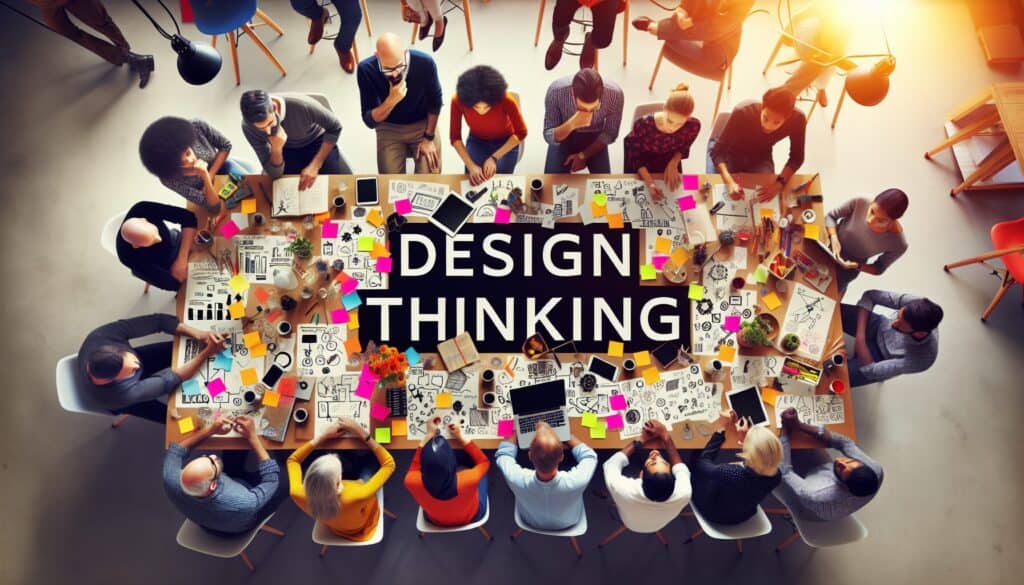A human-centered, iterative approach to problem-solving and innovation that focuses on understanding user needs, challenging assumptions, redefining problems, and creating innovative solutions to prototype and test.
- المنهجيات: العملاء والتسويق, الاقتصاد
التفكير التصميمي

التفكير التصميمي
- التعاون بين الوظائف, عملية التصميم, التفكير التصميمي, التصميم المرتكز على الإنسان, الأفكار, ابتكار, النماذج الأولية, تجربة المستخدم (UX), تصميم يركز على المستخدم
الهدف:
كيفية استخدامه:
- Typically involves five phases: Empathize (understand users), Define (frame the problem), Ideate (brainstorm solutions), Prototype (create tangible representations), and Test (get user feedback). These phases are iterative and non-linear.
الايجابيات
- Focuses deeply on user needs leading to more desirable solutions; Encourages creativity and innovation; Reduces risk by testing ideas early and often; Promotes collaboration among multidisciplinary teams.
سلبيات
- Can be time-consuming and may not always lead to a clear-cut solution quickly; Requires a mindset shift and can be challenging to implement in rigid organizational cultures; Success depends on the team's ability to empathize and iterate effectively.
الفئات:
- العملاء والتسويق, الأفكار, حل المشكلات, تصميم المنتج
الأفضل لـ
- Solving complex, ill-defined problems by focusing on user needs and rapidly iterating on potential solutions.
Design Thinking is utilized across a wide range of industries, including technology, healthcare, education, and consumer goods, owing to its adaptability in solving multifaceted issues through a user-centric approach. Organizations often initiate this methodology during the early stages of product development or when rethinking existing services, facilitating collaboration among diverse stakeholders such as designers, engineers, marketers, and end-users. Each phase of Design Thinking can be employed recursively, allowing teams to revisit previous steps based on feedback and new findings, which enhances the depth of understanding regarding user experiences. For example, a tech company might employ Design Thinking to develop a new app, starting with extensive user interviews to gain insights into user habits before defining the core problems that the app aims to solve. Workshops during the Ideate phase can unleash creativity, leading to a plethora of innovative solutions, from simple feature modifications to entirely new functionalities. Once prototypes are produced, iterative testing not only validates concepts but also uncovers unforeseen challenges or opportunities, allowing for refinement that aligns with actual user needs. By fostering collaboration across disciplines, from engineering to marketing, organizations cultivate a culture that embraces experimentation and iterative learning, thereby increasing the likelihood of market acceptance and success. Users play a pivotal part in this process; their feedback is paramount, making the final product more aligned with their preferences while significantly reducing the risk associated with new launches.
الخطوات الرئيسية لهذه المنهجية
- Conduct user interviews and observations.
- Identify key user needs and pain points.
- Articulate a clear problem statement.
- Brainstorm a wide range of potential solutions.
- Select promising ideas for further development.
- Create low-fidelity prototypes for concepts.
- Gather user feedback on prototypes.
- Refine solutions based on feedback.
- Iterate on prototypes and retest.
نصائح للمحترفين
- Engage stakeholders early and encourage their involvement throughout the design process for diverse perspectives and greater buy-in.
- Utilize collaborative tools that facilitate real-time feedback and iterations, ensuring efficient transitions between phases.
- Incorporate storytelling techniques in presentations to convey design concepts effectively and foster emotional connections with users.
لقراءة عدة منهجيات ومقارنتها, نوصي باستخدام
> مستودع المنهجيات الشامل <
مع أكثر من 400 منهجية أخرى.
نرحب بتعليقاتكم على هذه المنهجية أو المعلومات الإضافية على قسم التعليقات أدناه ↓، وكذلك أي أفكار أو روابط متعلقة بالهندسة.
السياق التاريخي
1949
1950
1950
1960
1960
1960
1960
1940
1950
1950
1958
1960
1960
1960
1960
(إذا كان التاريخ غير معروف أو غير ذي صلة، على سبيل المثال "ميكانيكا الموائع"، يتم تقديم تقدير تقريبي لظهوره الملحوظ)















منشورات ذات صلة
جدول الإنتاج الرئيسي (MPS)
التخصيص الشامل
قمع التسويق
التدقيق التسويقي
مؤشر MAPO (حركة ومساعدة مرضى المستشفيات)
تخطيط موارد التصنيع (MRP II)